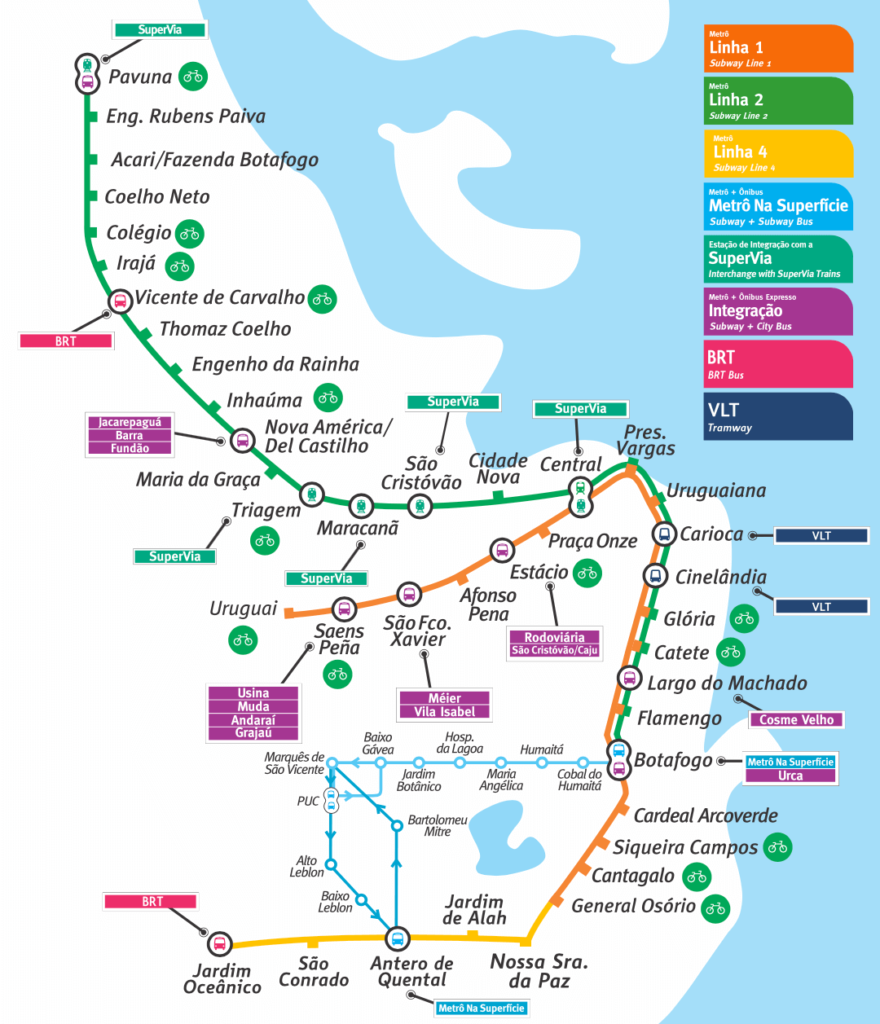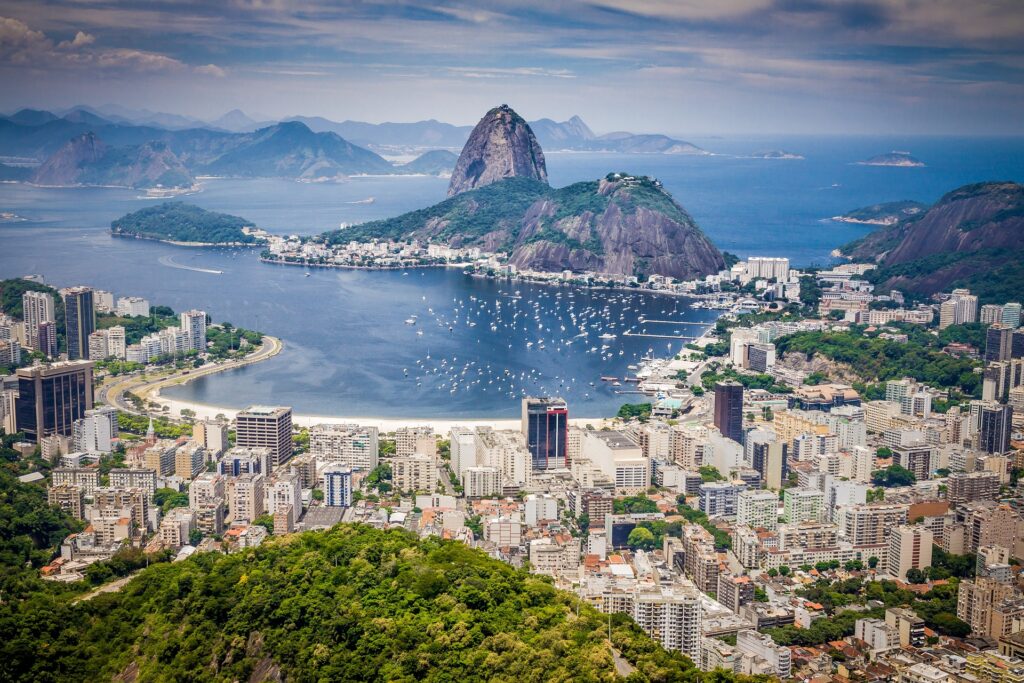A vast network of public transit provides the city of Rio de Janeiro with excellent connectivity. The city is served by a large public transportation system that includes metros, trams, buses, and ferries. Buses are by far the most utilized mode of public transportation in Rio due to the city’s extensive network of routes and the high frequency of their services. In addition to its effectiveness and dependability, the metro system serves a significant portion of the city. The bus and subway networks are more complete than the tram system, which is utilized primarily by visitors but is not as extensive. Last but not least, some of the islands located off the coast of Rio de Janeiro are connected to one another via ferries.
Metro system in Rio de Janeiro – MetrôRio
The metro system in Rio de Janeiro is a mode of public transportation in the city that is known for its convenience and dependability. It includes a monorail system, in addition to three different metro lines and two different rail lines. There are three metro lines: the Red, Green, and Yellow lines. There are also two railway lines: the Mangueira light rail and the SuperVia suburban train. The Santos Dumont Airport and the Galeo International Airport are connected by a monorail system that operates between the two main terminals. The SuperVia and Mangueira lines are primarily used for commuter traffic to areas located on the city’s periphery, although the metro lines reach the vast majority of the city’s most popular tourist destinations. It is simple to travel all across Rio de Janeiro thanks to the fact that the metro system is interconnected with both the city’s bus and ferry networks.
The lines of the Rio de Janeiro subway system
Line 1 – Oranga (Linha 1)
Rio de Janeiro Metro Line 1 serves the Downtown Business Center, South Zone Tourist Areas, and North Zone Neighborhoods. Line 1 crosses the South Zone. This railway is semicircular and underground. It may reach General Osório from Uruguay. The first line of the Rio de Janeiro Metro was built between June 1970 and March 1979.
Line 2 – Green (Linha 2)
Rio de Janeiro Metro Line 2 serves northward-expanding working-class neighborhoods. It runs diagonally over graded and high ground. As ridership expanded, this light rail line became a metro line. Due to its light rail roots, only the Estácio station rises above ground level. The Cidade Nova station will.
Line 4 – Yellow (Linha 4)
Line 4 is Rio de Janeiro’s third metro line. It passes under So Conrado and Rocinha to connect Barra da Tijuca in the West Zone to Ipanema in the South Zone. Except at Barra da Tijuca, where trains exit a tunnel, cross an elevated bridge, and return to the tunnel system, all stations are underground. Line 4 had six unique stations: Jardim Oceanico, São Conrado, Gávea, Antero de Quental, Jardim de Alah, and Nossa Senhora do Paz. As of April 2023, only Gávea Station has not opened for Line 4.
Map of Rio de Janeiro Metro 2023 – Free Download in PDF

Click on the image and download the map of Rio de Janeiro´s underground system for 2023
Everyone who comes to the city should bring along the Map of Rio de Janeiro Metro 2023. It is an indispensable resource. It is available for free download in PDF format and offers a map that is simple to read for both visitors and residents of the area. With the help of this map, you will have no trouble finding the closest metro stop or determining the most direct path to any location within the city. In order to provide you with a well-rounded experience of Rio de Janeiro and its environs, the map also includes information on the surrounding area’s restaurants, stores, and attractions. You may make your trip to the city simpler and more pleasurable by making use of the free Rio de Janeiro Metro Map 2023 that you can download right now.
Public transport tickets in Rio de janeiro – Best types for travelers & actual prices
Visitors visiting Rio de Janeiro will find that utilizing the city’s public transit system is an excellent choice for getting around the city. Visitors can choose from a number of different ticket options, based on the length of time they intend to spend at the attraction and the amount of money they are willing to spend. The following is a brief explanation of the many categories of tickets that can be purchased as well as the pricing that correspond with each one.
The RioCard is by far the most well-liked option among tourists that come to Rio de Janeiro. A pre-paid card known as the RioCard is sold at all of the city’s metro stations. It can be loaded with a variety of tickets of varying types and is good for use for a period of ninety days. Prices start at R$5.50 for a ticket that only goes in one direction, and go up to R$17.50 for an unlimited pass.
Tickets for Buses and Trains: Tickets for buses and trains can be purchased separately for each individual trip. Prices start at R$2.25 for a ticket that only goes in one direction, and go up to R$14 for an unlimited pass.
Visitors to Rio de Janeiro who intend to remain in the city for a period of three days have the greatest option available to them by purchasing a RioCard that includes an unlimited permit. You will get unrestricted access to the public transportation networks of the metro, bus, and train with this, and you will end up saving money as a result.
Timetables & Schedules of the Rio de Janeiro Metro System
The Metro system in Rio de Janeiro is operational every day from 5 am to midnight, with certain routes operating until 2 am on Fridays and Saturdays. Trains depart around every three to five minutes during peak hours, but during off-peak hours, trains depart approximately every ten to fifteen minutes. The Metro is open for service on Sundays from 7 am to 11 pm. Ticket vending machines, human-staffed ticket counters, and information desks can be found at each stop. In addition, the Metro system is accessible to those with disabilities and includes ramps and elevators in its stations.
What Are Other Options For Public Transportation In Rio de janeiro?
Getting around Rio de Janeiro, whether you live there or are just visiting, can be significantly easier if you take advantage of the city’s extensive public transit system. There are numerous methods available for navigating the city in addition to taking the subway, although many people choose to do so. The city of Rio de Janeiro provides a diverse selection of options for public transportation, including buses, taxis, and ferries.
Buses are a common and convenient mode of public transportation in Rio de Janeiro. There is a bus network in the city that consists of over 600 buses and has routes that cover the majority of the city. Buses are an excellent mode of transportation since they are reasonably priced, dependable, and frequent. The majority of the time, fares are paid for using a prepaid card, and tickets can be purchased from kiosks or convenience stores.
Taxis are yet another well-liked mode of public transportation in Rio de Janeiro. Taxis are a practical mode of transportation since they are simple to flag down and they can get you to your destination in a short amount of time. Taxis are far more expensive than buses, but if time is of the essence, it may be worthwhile to shell out the extra cash for a taxi ride.
In addition, there are ferry services available in Rio de Janeiro. There are two primary boat routes that may be taken, one of which connects the airport to the beaches of Niterói, while the other connects the city center to the beaches. Ferries are a fantastic kind of transportation since not only are they inexpensive, but they also provide passengers with breathtaking panoramas of the city.
There are private automobile services accessible for people who would prefer not to rely on the public transit system when getting around town. There are a number of businesses in Rio de Janeiro that provide private automobile services, and these services can be reserved through a website or an app on a mobile device. Even though the cost of using a private car service is more than the cost of using other types of public transportation, using a private car service is an easy and dependable method to travel around.
How To Get From Rio de Janeiro/Galeão International Airport (gig) To The City Center With Public Transport?
A trip to Rio de Janeiro is an excellent chance to get a taste of Brazil’s pulsating culture as well as its breathtaking natural scenery. The first thing that most tourists do when they arrive in a new city is to fly into Galeao International Airport, which is the city’s primary airport. After you have arrived, using public transit to travel from the airport to the core of the city is a simple and straightforward process.
The bus is the most time- and money-efficient mode of transportation between the airport and the central business district of the city. Both the Real Alagoas and the Executivo Alagoas bus lines provide transportation to and from the airport. Both lines provide direct service to the city center as well as the neighborhoods that surround it. The Real Alagoas bus route leaves the Arrivals Terminal of the airport every fifteen minutes and travels across the city. It makes stops at a number of locations within the central business district, such as Praca XV, Cinelandia, and Praca Mauá. The Executivo Alagoas line leaves the airport’s Departures Terminal at regular intervals of thirty minutes each and every day. It makes stops at a number of locations within the central business district, such as Praca Mauá, Estácio, and Copacabana.
The SuperVia rail line may take you to and from the airport if you’d rather take that mode of transportation. It leaves the airport’s Departures Terminal every half an hour and travels in a circular pattern. The railway makes stops at a number of locations in the central business district, including Estácio, Praca Mauá, and Copacabana.
What kind of sightseeing do you have to see if you visit Rio de Janeiro for the first time?
Rio de Janeiro is often regarded as one of the most attractive cities in the world and is widely regarded as the ideal place to spend a holiday. Rio de Janeiro is a city that never runs out of things to do because to its abundance of beautiful beaches, vibrant culture, and one-of-a-kind attractions. Here are some of the best things to see and do in Rio de Janeiro, Brazil, ranging from well-known landmarks to little-known treasures.
The Christ the Redeemer statue is the first attraction that visitors to Rio de Janeiro absolutely cannot miss. This famous statue is one of the most well-known landmarks in the entire globe, and it can be seen atop the peak of the Corcovado mountain. The trip is also well worth it in order to take in the beautiful views of the city that can be had from the peak of the mountain.
The Sugarloaf Mountain is yet another well-known landmark in the city of Rio de Janeiro. This famous summit looks out over the city and offers breathtaking panoramas of both the city and the ocean below. Another experience that should not be missed is riding the cable car to the peak of the mountain.
The beaches of Rio de Janeiro are another attraction that you just cannot miss. Copacabana Beach is well-known for being one of the most energetic and exciting beaches in the city. It is also one of the most popular beaches in the city. Ipanema Beach is another prominent beach in Rio de Janeiro, and it is known for having some of the most well-known and acclaimed restaurants and nightlife spots in the city.
Exploring the streets of Rio de Janeiro can provide tourists with a more culturally enriching experience. The city is teeming with brilliant street art and markets that are full of color. In addition, there are a lot of museums and galleries in the area, such as the National Museum of Fine Arts and the Museum of Modern Art, both of which are worth checking out.
Last but not least, a trip to Rio de Janeiro would be incomplete without a trip to the city’s world-famous Carnival. This festival, which is celebrated annually and is famous all over the world, includes parades, music, and dancing. It is a truly one-of-a-kind adventure that one must partake in in order to believe it.
In conclusion, Rio de Janeiro is home to a plethora of tourist destinations that are well worth exploring. In this bustling metropolis, there is something for everyone to take pleasure in, from well-known points of interest to little-known attractions. Rio de Janeiro is the ideal place to go on vacation if you want to have a memorable experience, whether you are interested in having a beach holiday or participating in cultural activities.
Summary of our tour guide for Rio de Janeiro
Rio de Janeiro, the capital city of the Brazilian state of Rio de Janeiro, is a world-famous destination that is famous for the breathtaking natural beauty, vibrant culture, and fascinating attractions that it offers. Rio de Janeiro is a city in Brazil that is one of the most visited cities in the world due to its location between the mountains and the sea. Buses, taxis, and even a metro system are all part of the city’s well-developed and highly functional public transportation network. Buses are Rio de Janeiro’s primary mode of public transportation and provide a convenient and cost-effective means of moving throughout the city. The metro system is extremely dependable and operates all throughout the city, making it possible for tourists to reach their location of choice in a short amount of time. In addition, taxis are more reasonably priced than the other modes of public transit and may be found at a variety of locations across the city.
Top 5 FAQs and answers about Rio de Janeiro public transport?
What other modes of public transportation are there to choose from?
- Buses, metros, light rail, ferries, cable cars, and even cable cars are all part of Rio de Janeiro’s extensive public transportation system. It is easy to navigate around the city because to the extensive network of metro lines, which cover most of the urban areas. Buses depart from key hubs located all across the city, contributing to the city’s large bus network. There are light-rail lines that connect some of the outskirting suburbs with the city center, allowing for longer travels to be taken on these routes. Those who are interested in an alternate mode of transportation can take use of the city’s cable cars or one of the many ferry lines that traverse the city’s various rivers.
How much does it cost to take the public transportation?
- The price of riding Rio de Janeiro’s public transportation might change significantly based on the mode of conveyance that you choose. The normal fare for a ride on the metro is approximately R$4.50, but the cost of a ride on a bus or light rail is approximately R$3.50. The cost of a ferry ride is approximately R$7.50, and a cable car ride costs approximately R$9.50.
Is it safe to take public transportation?
- Although the public transportation system in Rio de Janeiro is generally considered to be secure, there is, as there is in any other public transportation system, always the possibility of criminals. When traveling, it is best to take measures, such as avoiding traveling alone during late hours of the night and remaining alert of your surroundings at all times.
Is there a mobile app that I can download to assist me in navigating the system?
- You can get assistance navigating the system by downloading an app called “Rio de Janeiro Public Transport.” This app is available for both iOS and Android devices. The application offers up-to-date information on the bus schedules and routes, in addition to supplying users with other pertinent details regarding the public transportation network.
Is a day pass still available for purchase?
- There is, in fact, a day pass that can be purchased for R$19. With the purchase of a day pass, you will have access to all of the public transportation systems in the city for an entire day, allowing you to make an unlimited number of trips. If you intend to travel within the city on several occasions, taking advantage of this money-saving opportunity is highly recommended.







